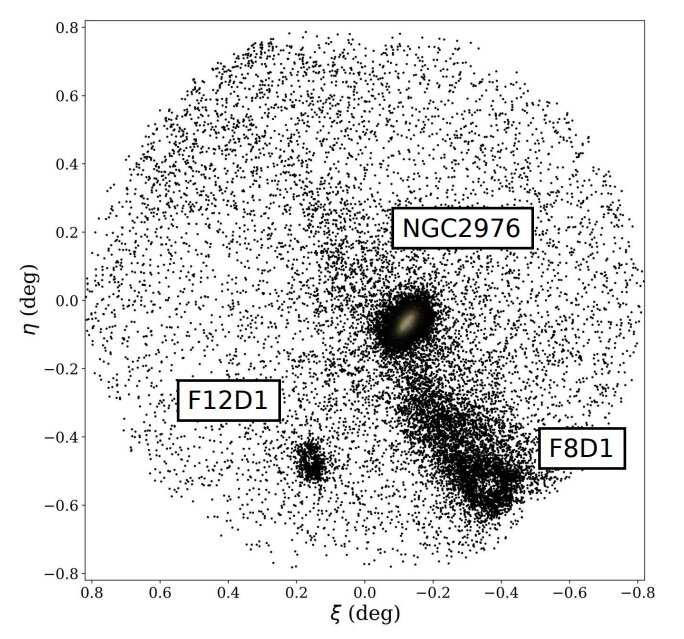Using the Subaru telescope and the Canada-France-Hawaii telescope CFHT, an international team of astronomers
Ultradiffuse galaxies (UDG) aregalaxies with extremely low density. The largest of them are similar in size to the Milky Way, but they contain only about 1% of the stars in our galaxy. The mystery of the UDG still baffles scientists who are trying to explain why these dim but large galaxies are so strange - they are not torn apart by the tidal field of their parent clusters. Previously, Hi-Tech talked about dark matter halos in galaxies of this type.
Galaxy F8D1 is the closest to the Milky WayUDG in the M81 group (a group of galaxies in the constellations Ursa Major and the Giraffe). It is located about 12 million light-years away, with an effective radius of 8 150 light-years and a luminosity of about 40 million Suns.
 RGB star count density in the HSC image.A giant tidal stream is visible emanating from F8D1, which is located on the southwestern edge. The flow is traced more than a degree to the northeast, towards NGC 2976 and M81. Credit: Zemaitis et al., 2022
RGB star count density in the HSC image.A giant tidal stream is visible emanating from F8D1, which is located on the southwestern edge. The flow is traced more than a degree to the northeast, towards NGC 2976 and M81. Credit: Zemaitis et al., 2022
Although F8D1 was discovered in 1998, in the past itlittle has been studied. Now a team of astronomers led by Rokas Zemaitis from the University of Edinburgh, UK, has used the Subaru telescope's Hyper Suprime-Cam (HSC) and the CFHT's MegaCam to study this UDG.
During their observations, they discovered a giant streamstars, which extends from F8D1 to the northwest, towards the galaxies NGC 2976 and M81. This feature can be seen on both sides of NGC 2976. The stream bends about 0.8 arcminutes west of the main body at small radii and changes direction at large radii, curving about 1.1 arcminutes to the east at a distance of 40–60 arcminutes. The tidal stream spans at least 195,000 light years.
Read more:
It turned out what happens to the human brain after one hour in the forest
It became known which tea destroys protein in the brain
Strange sea creatures in the depths of the ocean turned out to be similar to humans
Cover photo: NGC 4676. Source: NASA, H. Ford (JHU), G. Illingworth (UCSC/LO), M. Clampin (STScI), G. Hartig (STScI), ACS Science Group and ESA